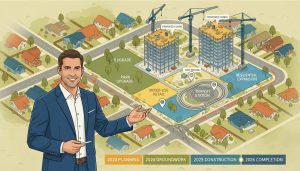What are the future development plans in my area?
Want to know exactly what’s going up near your home—and how it will affect your property value?
Quick answer: Where to find future development plans
Future development plans in your area are public, trackable, and predictable if you know where to look. Start with municipal planning documents, zoning maps, city council agendas, and transit agency plans. Add developer proposals, building permit filings, and community consultations. Put those together and you get a clear picture of what will change, when, and how it will affect neighborhood growth.
How development plans actually impact your street
When a mid-rise, a transit station, or a new commercial node is announced, three things happen fast:
- Demand shifts: More buyers and renters target the area.
- Zoning follows: Re-zoning or minor variances tell you what’s allowed next.
- Infrastructure upgrades: Roads, sewers, parks and transit improve, lifting property values.
These aren’t guesses. They’re the chain reaction developers and planners use to create neighborhoods.

Simple checklist to uncover plans for your area
Follow this checklist today. It takes 15–30 minutes and gives a reliable snapshot:
- Check your city’s official plan and growth strategy.
- Review zoning maps and land-use bylaws.
- Search city council and planning committee agendas for “site plan,” “rezoning,” or “OPA.”
- Look at transit agency expansion plans and provincial infrastructure projects.
- Scan building permit records for large residential or commercial filings.
- Visit developer websites and project renderings.
- Read community consultation notices and public meeting minutes.
What to read in those documents (so you’re not guessing)
Focus on: proposed density, building height, parking requirements, public realm upgrades, timeline, and developer contributions (like parks or transit funding). These details tell you if the change is cosmetic or transformative.
How professionals use this information (and how you can too)
Real estate pros turn raw planning data into actionable advice: price forecasts, hold/sell recommendations, and renovation timing. They look for trigger events—zoning approvals, issued permits, and financing close—that confirm a project will happen.
I use that same playbook to advise homeowners and investors. When a rezoning is approved or a transit stop is funded, decisions move from speculative to strategic.
Bottom line: what this means for your home value
Planned density, transit, and commercial investment usually drive appreciation. Short-term disruptions happen during construction, but long-term gains come from improved accessibility, amenities, and new housing supply attracting demand.

Want a precise roadmap for your address?
I analyze municipal plans, track permit activity, and translate the technical language into simple, actionable advice. If you want a customized report for your property—what projects are planned, timelines, and realistic value impact—email me and I’ll send a clear, numbered plan you can act on.
Contact: tony@sousasells.ca | 416-477-2620 | https://www.sousasells.ca
No jargon. No hype. Just the facts transformed into a plan you can use.





















